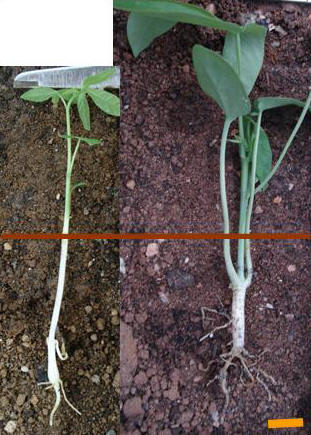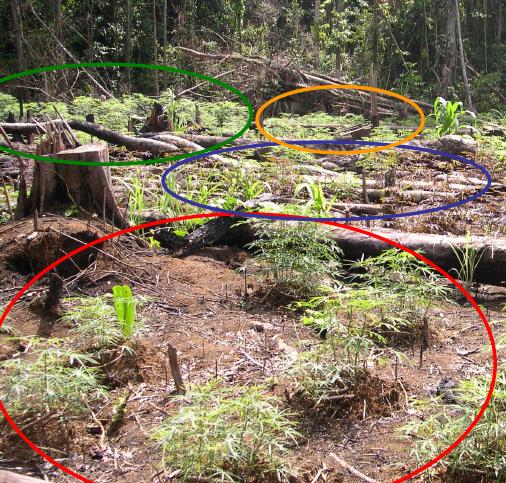Ecological and genetic modifications accompanying crop domestication: Ecological modifications
Crop domestication has usually been accompanied by ecological modifications that are not always straightforward. I studied the modifications of the mating system and of the germination ecology accompanying the domestication of cassava.

One of the traits characterizing cassava's domestication syndrome is a change in seedling morphology. While the wild progenitor of cassava has a plastic seedling morphology (PEF or CHR), cassava seedlings always germinate as PEF. This allows a faster initial growth, and I am interested in the trade-offs associated with this loss of plasticity.
Seedling morphology 8 days after germination. Left panel: Manihot esculenta ssp. flabellifolia with Cryptocotylar, Hypogeous, Reserve cotyledons germination type (CHR). Right panel: cultivated cassava, with Phanerocotylar, Epigeous, Foliaceous cotyledons (PEF) germination type. Brown line: soil level. Orange bar: 1 cm.
Cassava is usually propagated clonally, and farmers traditionally cultivate many phenotypically distinct landraces that they plant in monovarietal patches. Cassava plants are able to produce seeds, and some seedlings are incorporated in the stock of clones. This poses two problems: agronomic quality may decrease as some seedlings are inbred, and landrace identity may be progressively lost through the incorporation of unrelated seedlings.
 Working
with Amerindian
farmers in a village in French Guiana, I tried to understand how these
problems are avoided in traditional agroecosystems, through the joint
action of natural and artificial selection.
Working
with Amerindian
farmers in a village in French Guiana, I tried to understand how these
problems are avoided in traditional agroecosystems, through the joint
action of natural and artificial selection.
Several landraces planted in patches in a Wayampi Amerindian field, in southern French Guiana.